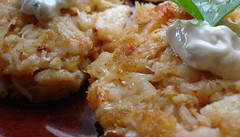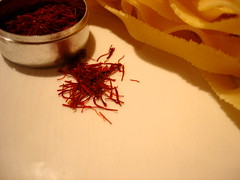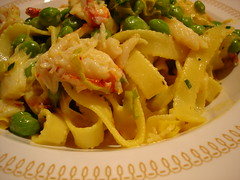A Pound of Crabmeat, or Two Crab Recipes in Two Days
We fell in love with M. Bertrand from a distance earlier this year when we read about him in Gourmet magazine’s profile of Martin Picard—a profile which dealt in large part with Picard’s relationship to high-quality, small-scale suppliers such as Bertrand. It had something to do with that disarming smile and that trademark straw hat of his,

but mostly it had to do with the descriptions of his garden and his fantastic organic produce. When M. Bertrand started to coming by Les Chèvres again this year to make his regular deliveries, Michelle finally worked up the courage to say hello, and late in the summer she asked him if the two of us might be able to stop by his garden some day to take a look around. He very kindly told her “yes,” and a couple of weeks later we made our little pilgrimage to his large garden out near Mirabel.
We’ll have more to say about this visit later, but one thing we didn’t realize before we talked to him that fine summer morning was that M. Bertrand’s cottage business is about much more than just fruits, herbs, and vegetables. He also distributes seafood, and especially Quebec crabs, harvested by his brother-in-law in the Gaspé region of eastern Quebec. He told us all about the crab feasts he’d been having and we were nearly beside ourselves with envy, but we maintained our composure and decided that we’d try to procure some of M. Bertrand’s crab through the restaurant at a later date. That later date was late last week. Michelle came home late one night and she showed up with a pound of M. Bertrand’s finest Rock Crab lump crabmeat in tow. It looked and tasted so good we decided we’d try to stretch out into two meals. And that’s exactly what we did.
Meal #1: crab cakes
I spent a good part of my youth in the Washington-Baltimore metro area, so I know a thing or two about a good crab cake. Michelle, on the other hand, had only ever had the overly breaded, overly fried hockey-puck variety that you find from time to time at receptions. She had an inkling of what a real crab cake might taste like, but she’d yet to experience a true crab cake epiphany. I’d never made what I would call a blue ribbon crab cake, but, then again, I hadn’t made a crab cake of any sort in years, and after years of drought I was eager. And with John and Matt Lewis Thorne’s Pot on the Fire in our corner we were pretty sure we’d manage to make a crab cake that packed a punch.
Originally we’d been thinking dinnertime for the crab cakes, but things took a swift turn. I began reading the Thornes’ chapter on “Crustaceans & Crumbs” and I noticed a footnote that cited an 1897 crab cake recipe from Marietta Hollyday’s Domestic Economy as being the earliest known crab cake recipe of any kind. The recipe was entitled “Crab Cakes for Breakfast (Very nice).” It was then that I knew we had no other recourse but to make our crab cakes for breakfast. Crab cakes are a bit of a brunch staple, of course, but with a couple of eggs over-easy and some sautéed chorizo I thought they might make for pretty mean breakfast too. And this way, ever so obliquely, we’d be communing with the very origins of the crab cake.
We followed the Thornes’ advice and steered clear of the croquette-type crab cake. Instead, we followed their Pigeon Hill Bay version, which seemed to have just the lightness of touch we were looking for, eschewing all that business that clutters most crab cakes in favor of a crab cake that lets its crabmeat shine.

Pigeon Hill Bay Crab Cakes
[Advance warning: This recipe is very simple, but it requires 1-2 hours of chilling time in the refrigerator so that the crab cakes firm up to the point that they can be fried properly.]
1 pound crabmeat, checked carefully for shell fragments
2 or 3 Saltine crackers, crumbled by hand
2 tbsp mayonnaise
1 generous dash Tabasco sauce
1/2 tsp spicy brown mustard
1 tbsp minced parsley
1/4 tsp salt
freshly ground black pepper to taste
3 to 4 tbsp butter for frying
Put the crabmeat in a mixing bowl and crumble the Saltine crackers into it. Blend the mayonnaise, Tabasco sauce, mustard, and parsley together, turn into the crabmeat mixture, and sprinkle this with the salt and black pepper. Using your fingers (or a rubber spatula), gently toss to produce a loosely textured crab salad.
[Frankly, if you can’t take it any longer you can quit here and just devour that salad, but we encourage you to see the recipe through. You won’t regret it.]
Take a biscuit cutter and set it on a large plate. Spoon approximately 1/8 of the crab mixture into the ring, tapping the ring gently when full to settle it. Remove the ring, set it elsewhere on the plate and repeat until you have 8 crab cakes. Put the plate in the refrigerator and let the crab cakes firm for 1-2 hours.
Meanwhile, to prevent the crab cakes from burning, put the butter in a heatproof measuring cup and place it in an oven turned to its lowest setting. After 15 minutes—or when the butter has turned clear and the butter solids have settled to the bottom of the cup—pour the liquid onto a griddle or large skillet, leaving behind and then discarding the butter solids.
When the moment of truth has arrived, remove the plate from the refrigerator. Heat the clarified butter in the griddle over medium-high heat. When the butter is hot, slide a thin-edged spatula under each crab cake ever so gently, and, with the gentlest of shakes, slip it onto the hot griddle. Fry the cakes until the bottoms are golden brown, about 2 minutes, then turn them over to cook on the other side. Serve at once (for breakfast, brunch, lunch, or dinner) with tartar sauce, preferably freshly made.
[Note: We halved this recipe so that we’d only used 1/2 of our crab. It made 4 beautiful crab cakes, just enough for a lovely Sunday breakfast.]

Meal #2: crab pasta
The next day we decided we’d be making some kind of pasta dish with the remaining crab. Those of you out there who’ve read us before know just how crazy we are about peas. Well, this year we’d frozen a bunch of our fresh pea haul and we’d been waiting for just the right occasion to bust them out. This seemed like the one. I’d experimented with pasta, seafood, and peas before, so I was pretty sure of where I wanted to go with this dish. I turned to a pasta with lobster and peas recipe from Tom Colicchio’s Think Like a Chef for a few pointers (quite a few, actually), but I had the idea that leeks and saffron might round out my variation nicely. The cream sauce turned into a work of art, and it made just enough to coat the noodles evenly without overwhelming the other flavors. We couldn’t have been happier with the results. Michelle quickly opened a bottle of wine and we sat down to savor the last of M. Bertrand’s crab. Just how good was it? Well, it instantly became one of Michelle’s favorite dishes of all time.

Fettucine with Crab and Peas
1 lb fettucine, preferably fresh
1 tbsp olive oil
1 clove garlic, minced
1 pinch high-quality saffron, crushed in a mortar + 1 tiny pinch saffron, uncrushed
1 leek, cleaned thoroughly and minced
sea salt
2 cups peas
1/2 lb fresh lump crabmeat
1 1/2 cups fish stock
1/2 tsp tomato paste
1 cup heavy cream
freshly ground black pepper
2 tbsp fresh chives, minced
2 tbsp fresh parsley, minced
In a heavy saucepan, heat the oil over medium heat. Add your garlic and sauté for one minute. Add the pinch of saffron and leek and sauté for about 5-10 minutes, until wilted. Salt to taste.
Meanwhile, add the tiny pinch of saffron to the fish stock and bring the stock to a simmer in a medium-sized pot over medium heat. Add the tomato paste and continue to cook over medium to medium-high heat until reduced by two-thirds (in other words, you should be left with roughly 1/2 cup of stock and the stock should have intensified considerably). Whisk in the cream, then simmer the mixture until it has reduced enough so that it coats the back of a spoon, about 10 minutes. Add salt and pepper to taste and keep the sauce warm over very low heat, stirring occasionally.
When the leeks are wilted, add the peas and cook them until just tender, but still crisp. Adjust the seasoning if necessary. Remove the leek and pea mixture from the heat.
Bring a large pot of salted water to boil and cook the fettucine until al dente.
When the pasta is just about done, add the leek and pea mixture along with half of the minced herbs to the cream sauce and heat through.
When the pasta is done, drain thoroughly and add to the cream sauce. Toss gently a couple times to begin coating the pasta with the sauce, the leeks and the peas. Add the crabmeat and the remaining herbs and toss everything very gently until just mixed. The crabmeat will heat through in the time that you toss it, without losing its delicate flavor.
Serve immediately.
Serves 4 for dinner, with side salad and plenty of crusty bread to sop up that delicious sauce.
aj
M. Bertrand photo courtesy of Gourmet









3 comments:
What do you know! I just received this morning from my wife's boss some fresh saffron that she bought from the Istanbul spice bazaar (she was vacationning there!)
So crab fettucine it is for the weekend meal! Now how do I convince my seafood-dubious visiting Mom-in-law that this is really chicken and not crab in the pasta! Any suggestions?
PS: say AJ, I have an almost empty bourbon bottle in my bar; once I kill it, I'll try keeping my regular maple syrup in it without rinsing the bottle first!
Hi Alexis,
How did it turn out? Did your mom-in-law like the "chicken"?
I like the gumption on the maple syrup front, but, trust me, there's nothing quite like the flavors of that cask. So you just might want to look into distilling then casking and ageing your own bourbon, just so you have a couple of smoky, bourbon-soaked receptacles around to store your grade A maple syrup in. Just a thought. That way you could joing our Bootleggers' Coalition too.
Hi AJ,
First, wife warned me not to try to fool Mom-in-law! She may be an old bird but she ain't dumb! We had the chicken! ... again!!
Do you know how hard is to climb 4 floors with 2 smoky bourbon-soaked receptacles??? plus i'm pretty sure it's illegal in our condo rules and wife is condo board secretary!
Post a Comment